The Future of Procurement: Top AI Platforms Driving Efficiency in 2025

Procurement teams face pressure to reduce costs and improve operations, with efficiency now hinging on data quality and supplier collaboration that extends beyond automation.
According to a recent Gartner survey, 98% of procurement leaders report that they’re deploying or planning to deploy GenAI; however, many struggle to turn this into measurable value due to fragmented data, integration gaps, and inconsistent inputs.
Procurement teams still face delays from incomplete and inconsistent supplier responses. AI now solves this by automating accuracy, compliance, and visibility across the RFx cycle.
TL;DR
- Procurement efficiency now depends on both data quality and supplier collaboration, rather than just sourcing automation.
- AI is transforming RFx cycles by improving supplier response accuracy, compliance, and speed, reducing evaluation delays.
- High-quality, structured responses enable faster and more confident sourcing decisions, as well as better alignment across stakeholders.
- Data readiness and change management are crucial for unlocking measurable ROI from procurement AI initiatives.
- The future of procurement is intelligent, connected, and collaborative, where AI drives both buyer efficiency and supplier enablement.
This list features the top AI solutions streamlining supplier responses, sourcing, and end-to-end procurement in 2025.
What Procurement Teams Need from AI Tools
Modern procurement teams operate at the intersection of speed, accuracy, and accountability, managing everything from supplier onboarding to contract management and RFPs.
Here’s what top-performing procurement teams truly need from AI solutions in 2025:
- High-Quality Supplier Responses: AI should help vendors submit complete, compliant, and comparable information across RFPs, RFQs, and vendor assessments. This reduces clarification cycles and ensures evaluation-ready, standardized data for faster decision-making.
- Faster Procurement Cycles: Beyond just RFPs, AI-driven drafting, validation, and approvals can speed up sourcing, vendor qualification, and contract workflows, turning weeks of manual effort into days, while maintaining accuracy and compliance.
- Better Evaluation & Decision Data: AI must structure responses and supplier data for completeness, compliance, and consistency, enabling fair comparisons across bids and stronger, data-backed sourcing decisions.
- Seamless Stakeholder Collaboration: Integrated AI workflows align procurement, finance, legal, and operations, enabling real-time visibility, accountability, and smoother communication throughout the sourcing lifecycle.
- Built-In Risk & Supplier Intelligence: Advanced analytics should surface supplier risk factors, performance insights, and compliance gaps proactively, helping teams make informed, forward-looking decisions within existing procurement systems.
- Governance, Auditability & Integration: AI tools must integrate seamlessly with ERP, CLM, and P2P systems, ensuring continuity from request to payment. Built-in audit trails and version control promote transparency and regulatory compliance.
Together, these capabilities define AI-driven procurement excellence, where RFP efficiency, supplier intelligence, and governance converge to create faster, smarter, and more resilient sourcing operations.
With these priorities in mind, here’s a quick comparison of the top AI tools transforming procurement in 2025.
Top AI Procurement Platforms Compared
Let’s take a closer look at them:
1. Inventive AI

Inventive AI is an AI-powered platform designed to solve one of procurement’s biggest challenges — slow, inconsistent, and non-compliant supplier responses.
Unlike traditional tools built for buyers, Inventive AI focuses on automating and elevating the supplier-side response process for Requests for Proposals (RFPs), Requests for Information (RFIs), and security questionnaires.
Why This Matters to Your Procurement Team
By improving the vendor experience, Inventive AI directly eliminates the clarification loops, data inaccuracies, and compliance gaps that delay sourcing projects. The result? Your team receives high-integrity, standardized, and evaluation-ready submissions from the start — empowering faster, more confident sourcing decisions.
Features & Benefits for Procurement Teams
Receive Supplier Responses up to 10× Faster: Inventive AI’s AI RFP Agent automatically drafts responses using verified company data, helping suppliers submit proposals up to 90% faster. For procurement teams, that means moving from sourcing to contract execution in record time.
Get 95% Accurate & Compliant Bids on Day One: The platform ensures fact-based, hallucination-free responses that align precisely with your requirements. This reduces manual corrections and lets your team focus on evaluating quality, not fixing content.
Eliminate Inconsistent Supplier Data: A Centralized Knowledge Hub stores each supplier’s approved answers, policies, and specs. Procurement teams benefit from clean, current, and standardized data, making comparisons fair and efficient.
Proactive Error Detection: The AI Content Manager monitors supplier data for outdated or conflicting details, flagging issues before submission. You receive 100% accurate, audit-ready responses, not last-minute surprises.
Receive Proposals That Actually Answer Your Questions: The proprietary Win Themes feature guides suppliers to align responses with your key criteria and evaluation metrics, producing targeted, high-quality answers instead of generic templates.
Improved Supplier Accountability & Visibility Real-time co-editing, task tracking, and progress dashboards help suppliers stay organized and on schedule — ensuring no missed deadlines or incomplete submissions on your end.
The Bottom Line for Procurement
- Accelerated Sourcing Cycles: Faster, high-quality, and ready-to-evaluate supplier submissions.
- Reduced Review Workload: Fewer clarifications and shorter evaluation timelines.
- Higher Supplier Engagement: Easier, smarter tools lead to more competitive bids.
- Smoother Stakeholder Coordination: Clean, compliant data ready for finance, compliance, and IT reviews.
Pros
- Generates context-aware, compliant supplier responses tailored to your RFx.
- Auto-detects inconsistencies before submission.
- Integrates with major procurement and document platforms.
- Ensures faster, audit-ready supplier submissions with built-in accuracy controls.
Cons
Limited analytics compared to advanced reporting platforms.
Gartner Ratings: 5/5
Best For
Procurement and sourcing teams that rely on high-quality supplier input to make informed, timely decisions, particularly in industries with complex RFP processes, such as technology, healthcare, government contracting, and finance.
Performance Metrics
- 10× Faster Response Drafting
- 95% Accuracy, 0% Hallucination
- 50% Higher Win Rates for Vendors
- 90% Reduction in Procurement Evaluation Delays
What our customers say
“Accurate, Sales-Ready Responses with Minimal Edits
Inventive helped us deliver confident, persuasive proposals that clearly showed why we were the best choice.”
Jason
Sr. Sales Engineer, Rad AI
2. Coupa AI / Coupa BSM

Coupa’s Business Spend Management (BSM) platform is a cloud-native suite that unifies procurement, invoicing, expense, and supplier management. With AI-native capabilities, it layers prescriptive and predictive intelligence over spend data to help organizations forecast, optimize, and automate financial and procurement decisions.
Features/Benefits
- Unified Spend Intelligence & Community AI: Coupa aggregates anonymized spend across its network and uses that “community intelligence” to surface benchmarking and pricing insights.
- Prescriptive & Predictive Insights: AI agents predict overspending areas, suggest cost/budget adjustments, and recommend supplier alternatives.
- Automated Workflow & Compliance: Coupa automates the purchase-to-pay process, enforces policies, monitors budget adherence, and flags anomalies.
- Supplier Network & Integration Ecosystem: With a large buyer–supplier network, Coupa enables seamless communication with suppliers and robust integrations with ERP and financial systems.
Pros
- Coupa offers a comprehensive platform that encompasses eProcurement, invoicing, expense management, and supplier management in a single, unified system.
- Its AI leverages community-driven intelligence to reveal spend patterns beyond internal data.
Cons
- AI performance relies on clean, well-classified spend data; disorganized spending histories weaken insight quality
- Full value often requires broad adoption across functions (finance, procurement, AP); partial rollouts may underdeliver
- Customizing AI rules, workflows, and exceptions can consume significant time and resources
- Hidden costs: Data cleansing, change management, and governance overhead are often underestimated.
Pricing
Coupa does not publish standard pricing.
Gartner Ratings: 4.6/5
Best For
Large and mid-market organizations seeking an integrated, AI-enhanced spend management platform across procurement, finance, and supplier networks. Especially suited for companies ready to invest in cross-functional adoption and data discipline.
3. SAP Ariba + SAP Procurement AI Modules

SAP Ariba is a cloud-based procurement and sourcing platform that integrates natively with SAP’s broader ERP and spend management stack. Its AI modules, branded under SAP Business AI & Spend Management, offer embedded intelligence for sourcing, category management, and spend visibility.
Features/Benefits
- AI-assisted sourcing & supplier matching: Ariba’s AI can analyze the supply base and suggest vendors tailored to the RFx criteria.
- Generative AI recommendations in category planning: Users can get content suggestions for category segmentation, market dynamics, and cost structure tools.
- Guided buying with policy enforcement: Embedded AI recommends catalog items and enforces procurement policies to reduce off-contract spend.
- Spend visibility & predictive insights: AI layers add spend forecasting, supplier risk signals, and scenario planning across sourcing modules.
Pros
- Deep alignment with SAP ERP and financial systems, reducing friction for SAP-centric enterprises
- Broad functional coverage across sourcing, contract, procurement, and supplier management
- Strong brand trust and global reach
Cons
- Heavy customization and long deployment cycles delay ROI, especially in complex environments
- AI effectiveness is contingent on highly cleansed, uniform ERP and procurement data
- Steep learning curve and configuration overhead, particularly for non-SAP architectures
- Costly implementation and maintenance overhead, especially when integrating with legacy systems
Pricing
SAP does not publicly list flat rates.
Gartner Ratings: 4.1/5
Best For
Large enterprises are already committed to SAP’s ecosystem, wanting unified procurement and ERP without duplicating vendor systems. Ideal when you need consistency across financial, supply chain, and procurement systems.
4. Ivalua + Ivalua Analytics
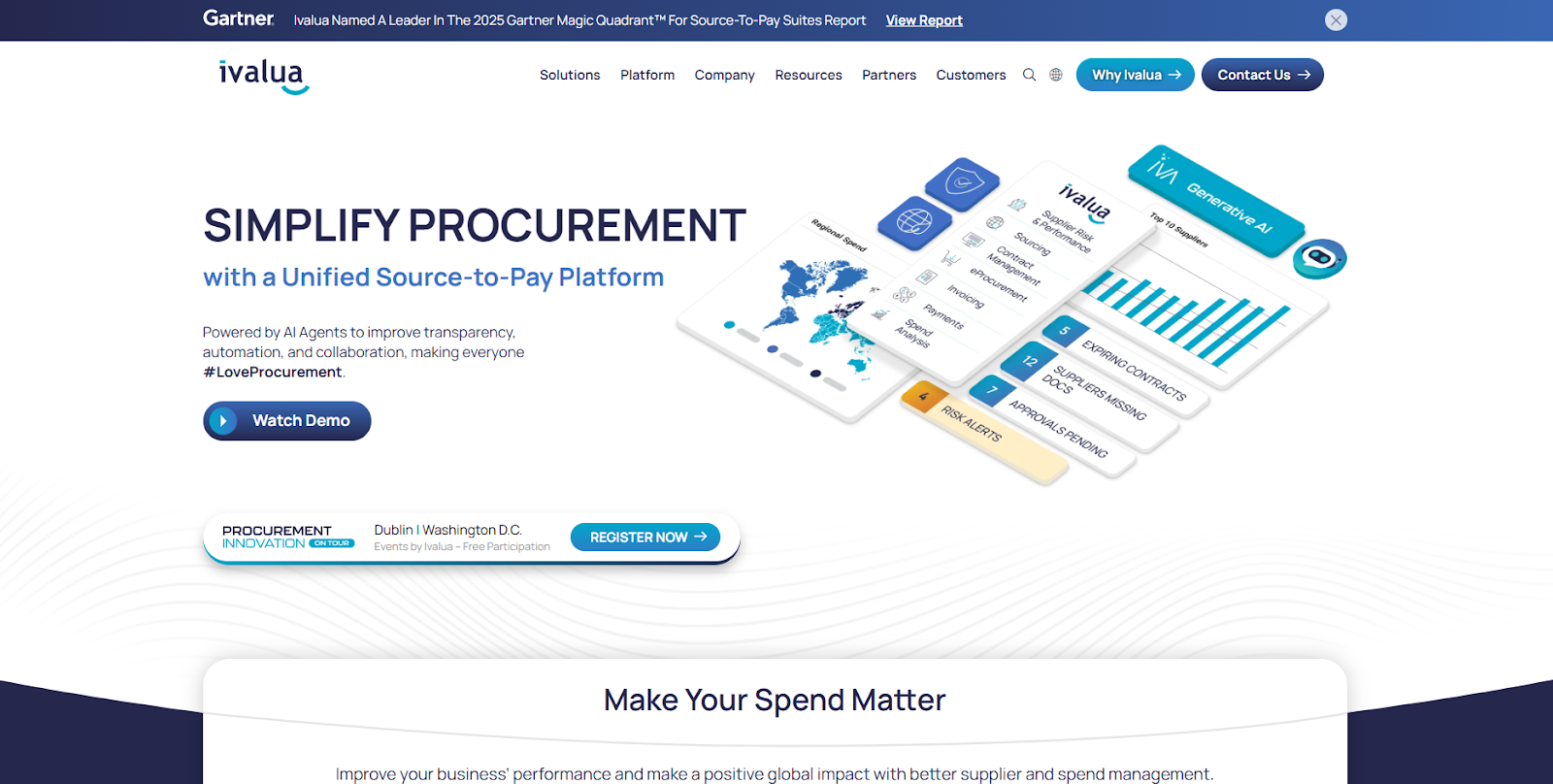
Ivalua offers a unified Source-to-Pay procurement platform designed to support every aspect of procurement, including sourcing, contracts, supplier management, spend analytics, and more. With Ivalua’s Intelligent Virtual Assistant (IVA) and generative AI modules, the platform aims to embed AI agents across procurement workflows.
Features/Benefits
- Generative AI Assistant (IVA): Supports supplier research, contract summarization, category and market insights, and guided communication from within the platform.
- Unified No-Code Platform: All modules share one data model and UI, enabling consistency across procurement workflows.
- AI-Enhanced Analytics & Insights: Mining spend, supplier performance, and contract data to surface opportunities, risk flags, and optimization signals.
- Conversational Intake Management: Newer AI chat interface to guide business users in submitting procurement requests while enforcing compliance and structure.
Pros
- Seamless integration within Ivalua’s ecosystem , no extra tools needed.
- Highly flexible with low-code customization for new procurement workflows.
- Unified data model ensures consistency and reduces context switching.
Cons
- Strong data governance is required for reliable AI output.
- AI insights need tuning to align with categories and sourcing rules.
- Adoption may lag due to concerns about user trust and resistance to change.
- Advanced AI setup adds configuration and training overhead.
- Potential bias toward historical supplier data may occur if not closely monitored.
Pricing
Ivalua does not publicize fixed pricing.
Gartner Ratings: 3/5
Best For
Organizations that already use Ivalua or want a single platform for comprehensive procurement operations and are ready to invest in data discipline.
When your sourcing decisions are hindered by supplier responses that are incomplete or inconsistent, even in Ivalua events, augment with Inventive AI to ensure structured, high-quality vendor submissions that streamline evaluation and reduce RFx back-and-forth.
5. Zycus - Merlin AI

Zycus is a procurement technology provider that embeds cognitive AI capabilities under its Merlin AI umbrella, designed to assist across sourcing, analytics, supplier management, and procurement operations. Merlin acts as a procurement assistant, surfacing insights, automating repetitive tasks, and enabling smarter sourcing decisions.
Features/Benefits
- Cognitive Sourcing Recommendations: Merlin suggests supplier matches, bid strategies, and sourcing scenarios based on historical sourcing data and market signals.
- Auto-RFx Drafting & Response Validation: Helps procurement teams build RFx templates and validates responses against standards.
- Spend Analytics & Opportunity Discovery: AI surfaces cost-reduction opportunities in spend data.
- Supplier Risk & Performance Insights: Merlin flags supplier risk indicators, contract compliance issues, and performance variances.
- Conversational Assistant: Enables natural-language queries (e.g., “Show me low-cost suppliers for Category X”) to speed sourcing decisions.
Pros
- Merlin can efficiently guide procurement workflows and shorten learning curves
- Zycus covers sourcing, contract, supplier management, analytics, and Merlin spans across modules
Cons
- While effective for standard RFx types, Merlin may struggle with custom, novel, or highly specialized buying cases
- AI may recommend repetitive patterns rather than novel innovation
- Adjusting AI recommendations to emerging buying strategies may require manual tuning
- Quality and completeness of supplier and spend data strongly influence output value
Pricing
Zycus does not publish fixed pricing.
Gartner Ratings: 4.6/5
Best For
Mid-to-large procurement organizations seeking an integrated procurement suite with embedded AI assistance, especially if many of your buying scenarios are repetitive or templateable.
Suggested Read: Top RFx Software Solutions to Watch in 2025
6. JAGGAER Autonomous Commerce

JAGGAER’s “Autonomous Commerce” vision seeks to transform procurement from reactive operations to a self-governing B2B commerce ecosystem. Through its Digital Mind / JAI agentic AI, the company aims to embed automation, predictive intelligence, and conversational orchestration across its integrated Source-to-Pay platform.
Features/Benefits
- Autonomous Agentic AI (JAI): Embedded conversational agents that can initiate tasks (e.g., RFP creation, supplier evaluation), answer natural language queries, and progressively evolve into orchestration across sourcing and contracts.
- Integrated Intelligence across Modules: AI-driven contract analysis, spend forecasting, supplier risk detection, and anomaly detection built into the JAGGAER One platform.
- Self-governing Commerce Network: Matching buyers and suppliers via smart recommendations that factor in cost, performance, risk, and ESG criteria.
- Extensibility & Plug-in Marketplace: Modular components allow buyers and suppliers to add custom apps and AI extensions without wholesale replacement.
Pros
- JAGGAER’s roadmap toward full autonomy positions it as a future-ready procurement platform
- Because Autonomous Commerce is part of JAGGAER One, AI features span procurement, contracting, supplier management, and more
Cons
- The full Autonomous Commerce suite is broad and ambitious, making system configuration, governance, and adoption difficult
- Diluted AI value if only a partial suite is used: If organizations adopt JAGGAER piecemeal, AI benefits may fall short due to missing context across modules
- Some JAI agent features are still under development or pilot; not all capabilities are fully autonomous yet
Pricing
JAGGAER does not publish fixed rates.
Gartner Ratings: 4.5/5
Best For
Large enterprises that aim to transform procurement into a largely autonomous process, and which have the maturity, data discipline, and change management capacity to support a full suite deployment.
7. LevaData

LevaData offers an AI-driven sourcing and supply chain intelligence platform, primarily focused on direct materials procurement. It combines real-time market data, pricing benchmarks, supplier performance metrics, and predictive analytics to enable procurement teams to make informed sourcing decisions.
Features/Benefits
- Cost Prediction & Market Intelligence: LevaData’s AI models analyze market trends, raw material pricing, and supplier behavior to forecast cost changes and suggest negotiation strategies.
- Spend Visibility at Part/BOM Level: The platform breaks down spend to the part level, enabling fine-grained benchmarking and optimization.
- Supplier Development & Risk Insights: LevaData surfaces supplier performance through scorecards, monitors supply risk from multiple data sources, and suggests alternate suppliers when disruptions arise.
- Dynamic Sourcing Intelligence: The solution can recommend sourcing strategies, detect opportunities to shift supply, and alert to margin erosion in real-time.
Pros
- Deep domain fit for industrial, manufacturing, and direct materials environments
- Granular spend and supplier visibility down to BOM / part level
- Predictive intelligence that helps procurement stay ahead of price shifts
- Well-suited for companies that already manage complex product structures
Cons
- Best value realized in manufacturing / direct material use cases; less optimized for services or indirect categories
- Requires clean BOM, product, and supplier datasets to train reliable models
- Off-the-shelf predictions may need calibration to your supply context and category logic
- To fully realize predictive insights, LevaData must integrate into ERP, PLM, and the master data system
Pricing
LevaData does not publish standard pricing.
Best For
Procurement organizations with heavy direct materials exposure, especially in manufacturing, electronics, or CPG, are looking to harness supply-market intelligence, predictive cost control, and fine-grained, part-level sourcing insight.
8. Sirion / Contract AI Modules

Sirion is an AI-native Contract Lifecycle Management (CLM) platform that infuses generative and conversational AI into every stage of contracting, automating extraction, risk detection, redlining, obligation tracking, and performance management.
Features/Benefits
- AI-driven contract ingestion & normalization: Sirion’s agents ingest existing and incoming contracts, extracting metadata, clauses, and obligations to structure a unified repository.
- Smart redlining & deviation detection: It flags deviations from playbooks and suggests clause edits based on historical negotiation data.
- Obligation / performance monitoring: Tracks SLAs, delivery, compliance, and triggers alerts on missed obligations or deviations.
- Conversational search & agentic queries: You can ask natural-language questions, such as “What are termination terms for Vendor X?” and the system returns contextually accurate answers with citations.
Pros
- Sirion’s agents claim up to 90% faster contraction of contract repositories.
- High accuracy in aligning executed performance data with contract terms
- Used by major corporations across 70+ countries
Cons
- AI models perform best when trained on a robust historical contract set; sparse or heterogeneous histories reduce effectiveness
- Complex, bespoke legal language or jurisdictional nuance may elude AI detection or result in false positives
- Initial model setup and continuous feedback loops are vital for maintaining precision in your domain
- Legal, procurement, and business stakeholders must accept AI’s redlining suggestions for value to materialize
Pricing
Sirion’s pricing is enterprise-custom and varies by repository size, module scope user base, and integrations.
Gartner Ratings: 4.9/5
Best For
Enterprises with large contract volumes seeking to automate legal review, obligation tracking, and performance compliance across procurement, sales, and vendor management functions.
9. GEP SMART / Procurement Intelligence
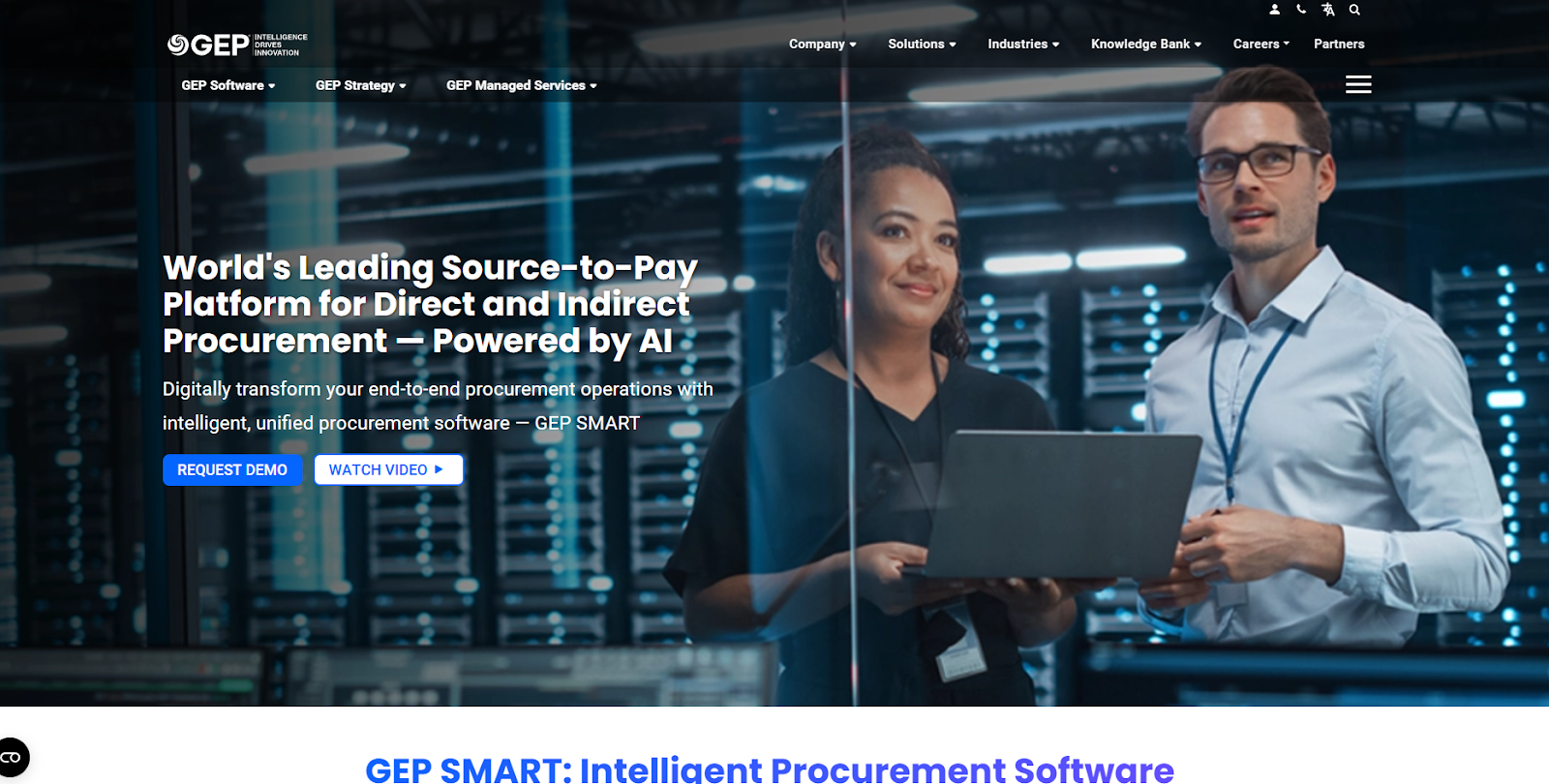
GEP SMART is a unified Source-to-Pay (S2P) procurement suite that combines end-to-end workflow orchestration with embedded Procurement Intelligence, advanced analytics, AI forecasting, and sourcing automation to optimize outcomes. (gep.com)
Features/Benefits
- Orchestrated Sourcing & AI-Driven Optimization: Automates RFP/RFQ design, supplier selection, multi-round bidding, and award recommendations.
- Procurement Intelligence & Analytics: Real-time dashboards, scenario modeling, supplier risk scoring, and spend opportunity insights.
- Category & Market Insights: Leverages external data to enrich sourcing decisions and benchmark costs.
- Integrated Workflow + Collaboration: Aligns cross-functional stakeholders (finance, legal, operations) within the procurement process.
Pros
- Designed to support global procurement programs across categories
- Combines sourcing, contract, spend, and supplier modules in one platform
- Deep AI signals help prioritize strategic sourcing opportunities
Cons
- Smaller procurement organizations may not fully leverage the platform’s advanced AI intelligence
- Without enough volume or cross-category adoption, ROI from its predictive models may be limited
- Implementing analytics models and orchestration workflows may require substantial capability and governance
Pricing
GEP SMART pricing is enterprise-quoted and depends on modules, user counts, and data usage.
Gartner Ratings: 4.6/5
Best For
Mid-market to large enterprises with cross-category procurement complexity, sufficient volume, and readiness to invest in analytics and governance.
10. Fairmarkit / Autonomous Sourcing
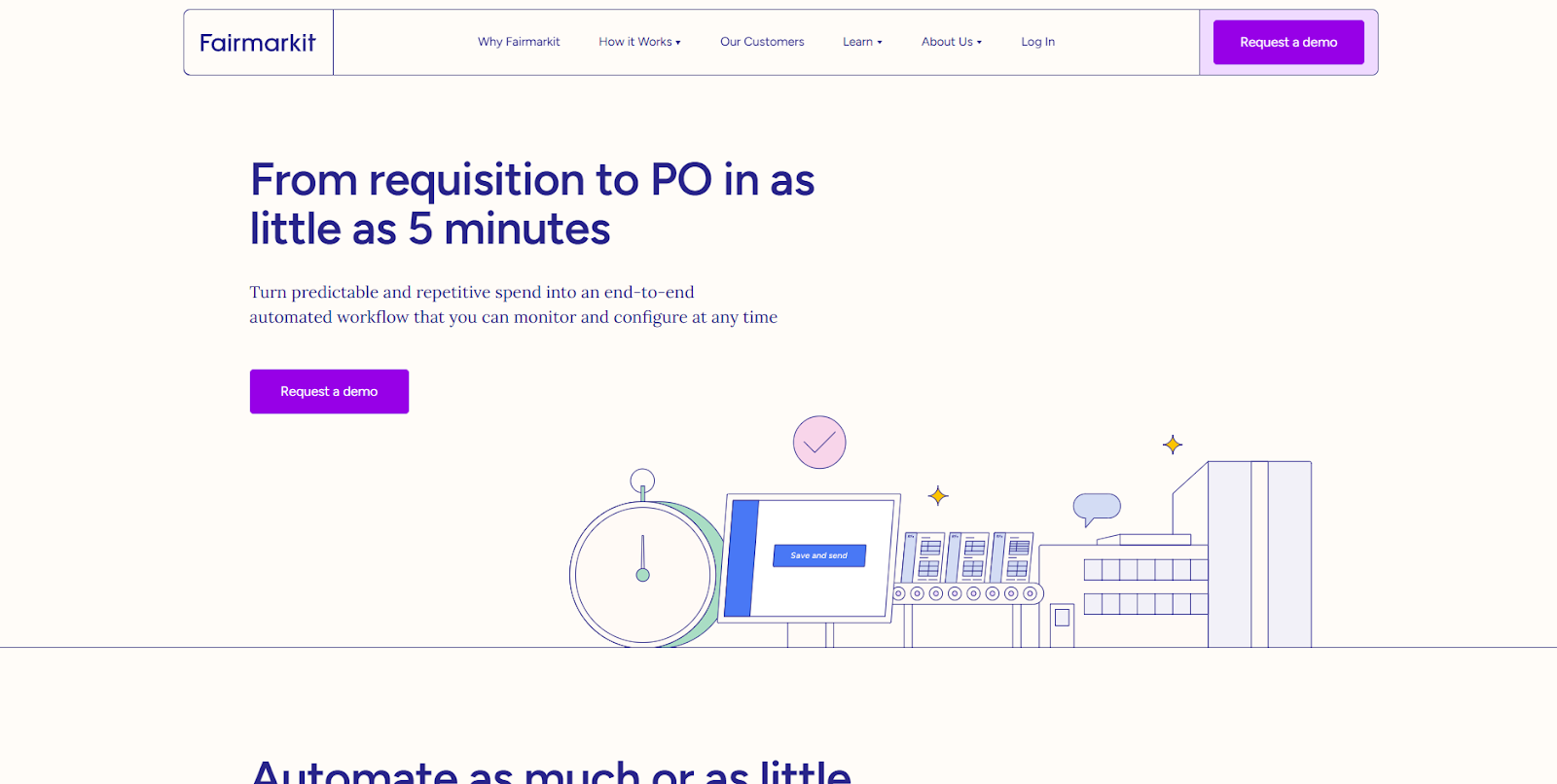
Fairmarkit is an AI-powered sourcing platform that automates the procurement of tail and indirect spend. The solution matches low-dollar, transactional requests to a broad supplier network using AI to create, execute, and analyze sourcing events with minimal human intervention.
Features/Benefits
- Autonomous Sourcing Engine: Automatically translates sourcing requests into events, solicits bids, and evaluates supplier quotes.
- Supplier Matching & Recommendation: AI recommends suppliers based on past behavior, capacity, and performance metrics.
- Bid Scoring & Analytics: Compare supplier offers dynamically based on cost, delivery, risk, and performance.
- Integration with P2P/ERP: Sourcing events are automatically integrated into existing procurement systems for order generation and tracking.
Pros
- Many manual sourcing tasks for tail spend have become fully automated
- Tail events that once took days or weeks can be handled in hours
- Helps discover and engage smaller or niche suppliers not traditionally in core sourcing
Cons
- Complex, high-risk, or technical sourcing often exceeds the platform’s automation capabilities
- AI scoring may struggle with bespoke requirements or nuanced supplier evaluation criteria
- Matching accuracy relies on consistent supplier master data and performance history
- Users may resist automation for complex or high-impact buys
Pricing
Fairmarkit does not publish standard pricing.
Gartner Ratings: 4/5
Best For
Organizations with extensive tail and indirect spend, where manual sourcing is costly and the business risk of automation is lower, such as maintenance, facilities, office supplies, and services.
By combining sourcing intelligence with supplier-side automation, procurement teams can accelerate decisions, ensure compliance, and unlock new levels of transparency and value across every stage of the sourcing lifecycle.
Implementation Recommendations for Procurement Leaders
To maximize ROI from procurement AI, leaders should focus on phased adoption, data readiness, and strong supplier collaboration from day one.
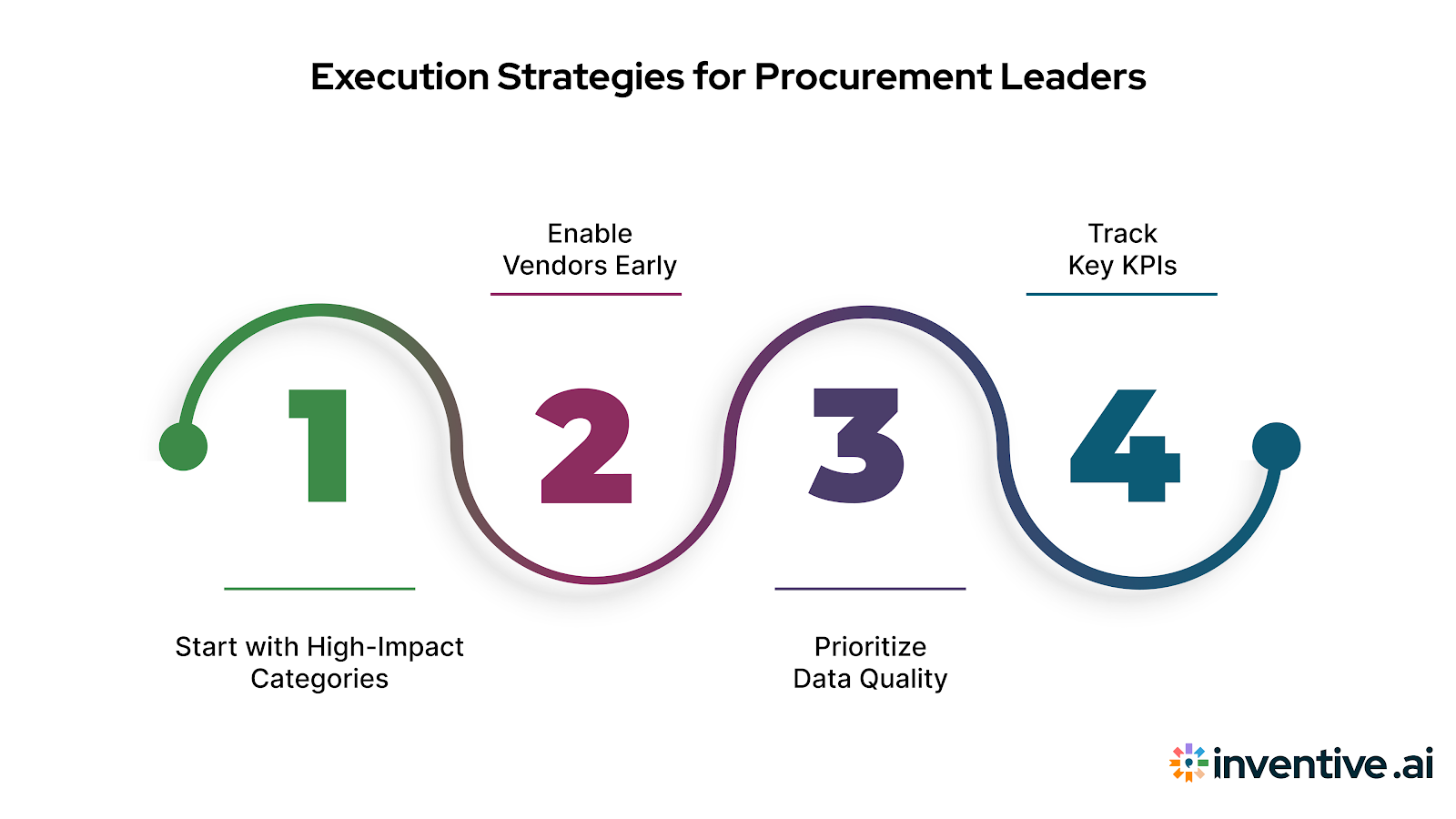
1. Start with High-Impact Categories
Begin AI adoption in high-volume areas like IT, services, or indirect spend to achieve quick efficiency wins and measurable automation results.
2. Enable Vendors Early
Train and onboard suppliers to use AI-enabled response tools, ensuring clear, complete submissions that reduce clarifications and speed evaluations.
3. Prioritize Data Quality
Clean and standardize supplier and spend data before rollout, AI delivers the best results when information is accurate and structured.
4. Track Key KPIs
Measure success with metrics like 40–60% RFx cycle reduction, fewer clarification rounds, higher vendor adoption, and improved response accuracy.
When deployed strategically, AI doesn’t just digitize procurement, it transforms it into a faster, smarter, and more collaborative function.
Suggested Read: The Complete Software RFP Question Bank
Pricing & Procurement Buying Tips
Understanding how AI tools are priced and what hidden costs lie beneath the surface is critical for procurement leaders. The right buying strategy ensures ROI and avoids surprise expenses.
1. Understand Vendor Pricing Models
AI procurement platforms use varying pricing structures, most commonly per usage, per module, or percentage of realized savings.
- Per usage: Best for smaller teams or pilot phases (e.g., charged per sourcing event or per supplier).
- Per module: Typical for enterprise suites like Coupa, SAP, or GEP, where sourcing, CLM, and analytics are priced separately.
- % of realized savings: Used by performance-based vendors that align pricing to measurable sourcing or process improvements.
Before finalizing, assess whether pricing aligns with your procurement maturity. Modular AI add-ons can quickly inflate total cost if used across multiple business units.
2. Watch for Hidden Costs
AI adoption often introduces secondary costs that aren’t visible in the initial quote:
- Data cleansing: Suppliers like SAP or Ivalua may require structured data preparation to enable AI models.
- Vendor support & enablement: Training suppliers and internal users may require additional resources.
- Integration overhead: APIs or connectors to ERP, P2P, or CLM systems can carry one-time setup or ongoing maintenance fees.
Factor these into your ROI model to avoid budget surprises post-implementation.
3. Evaluate ROI for Supplier Response Improvement
Traditional procurement ROI focuses on savings and compliance, but AI-enabled response tools, such as Inventive AI, redefine this metric by accelerating supplier collaboration and evaluation speed.
Measure impact across three key levers:
- Cycle Efficiency: Reduction in RFx turnaround time (target up to 90% faster response cycles).
- Response Quality: Improved completeness and accuracy in supplier submissions (reduces clarification rounds).
- Decision Velocity: Faster scoring, comparison, and award decisions, leading to earlier savings realization.
Procurement leaders should benchmark ROI not only by cost reduction but by decision agility , the ability to move from request to award faster and with higher confidence.
Solutions like Inventive AI elevate supplier engagement and internal efficiency, serving as a strategic multiplier in modern procurement stacks.
Risks, Compliance & Change Management
Adopting AI in procurement brings immense efficiency gains but also introduces challenges around data governance, compliance, and organizational adoption.
Addressing these risks early ensures sustainable, transparent, and trusted AI-driven operations.
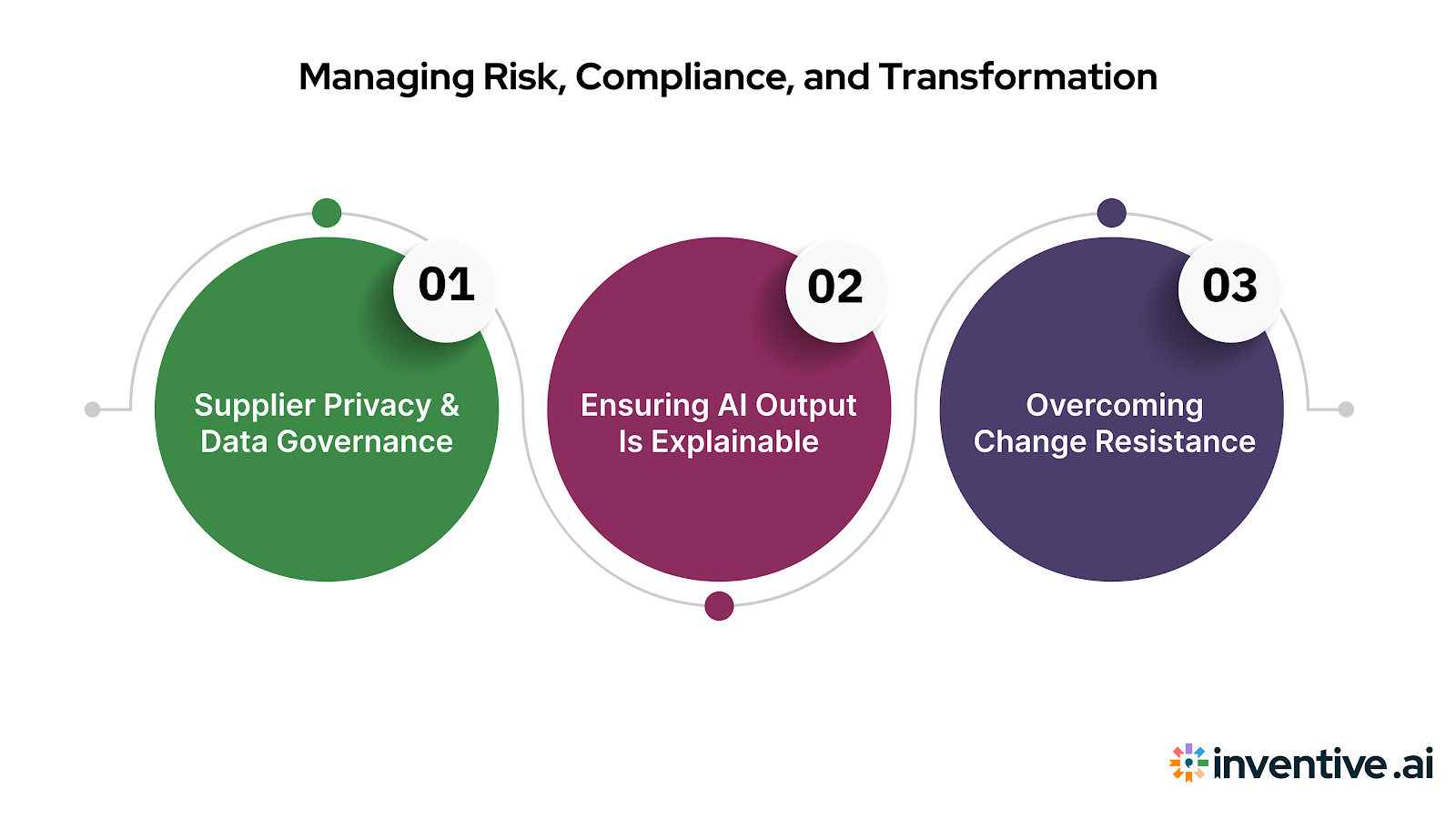
1. Supplier Privacy and Data Governance
AI tools in the procurement process are sensitive to supplier information, pricing, compliance records, and proprietary data. Leaders must ensure:
- Data residency and encryption: Platforms like Inventive AI operate within enterprise-grade security frameworks, ensuring no supplier data is retained or used for external AI training.
- Access controls and audit logs: Implement strict permission layers so only authorized users can view, edit, or export supplier responses.
- Third-party compliance: Verify SOC 2, ISO 27001, or GDPR compliance for every AI vendor involved in procurement workflows.
2. Ensuring AI Output Is Explainable and Defensible
As AI-driven sourcing decisions gain traction, procurement must remain transparent and auditable to ensure accountability and trust.
Select vendors that offer:
- Traceable AI logic: Clear evidence of how scoring, recommendations, or summaries are generated.
- Confidence scores: Like Inventive AI’s trust metrics or validation layers, which help reviewers understand output reliability.
- Human-in-the-loop review: Maintain accountability by requiring human validation for final decisions, especially in regulated or strategic categories.
3. Managing Change Resistance Across Teams and Suppliers
AI adoption often meets pushback from internal teams and external suppliers who fear loss of control or transparency.
To manage this:
- Start with pilot projects: Focus on a single category or region to demonstrate quick wins before scaling organization-wide.
- Train both buyers and suppliers: Tools like Inventive AI succeed when vendors understand how to collaborate with AI systems.
- Reinforce outcome-based success: Communicate metrics like faster RFx cycles, fewer clarifications, and improved decision accuracy to drive adoption.
With the right governance, explainability, and change management, AI becomes a trusted procurement partner, not a risk factor.
Platforms like Inventive AI demonstrate that automation can coexist with transparency and control, turning compliance and accountability into enablers, not obstacles, in digital procurement transformation.
Why Choose Inventive AI for Smarter Procurement Collaboration
Procurement efficiency doesn’t end with sourcing; it depends on how fast and accurately suppliers respond. Inventive AI bridges this critical gap by enabling vendor teams to deliver structured, high-quality responses that procurement teams can evaluate instantly.
With its AI-powered RFP Response Software, Inventive AI ensures that every supplier submission is accurate, compliant, and ready for comparison, cutting response cycles by up to 90% and improving decision clarity across all categories.
Conclusion
Modern procurement success isn’t just about sourcing efficiency; it’s about response quality, decision speed, and supplier collaboration. While most AI tools focus on spend analytics, forecasting, or compliance, the greatest friction still occurs on the vendor-response side of the process.
Inventive AI sets a new benchmark by automating supplier responses for speed, accuracy, and compliance, enabling faster evaluations, clearer comparisons, and more confident sourcing decisions.
FAQ’s
1. How is AI transforming procurement workflows in 2025?
AI is streamlining sourcing, supplier evaluation, and contract management by automating manual tasks, improving accuracy, and enabling data-driven decisions across the procurement lifecycle.
2. What should procurement teams consider before adopting AI tools?
Teams should assess data readiness, integration needs with existing ERP or CLM systems, and establish governance to ensure AI outputs are transparent, secure, and auditable.
3. How does AI improve collaboration between buyers and suppliers?
AI enables real-time collaboration, structured communication, and automatic validation of supplier inputs, reducing clarification cycles and accelerating approvals.
4. Are AI procurement tools difficult to integrate with legacy systems?
Most modern platforms offer API-based integration, but the ease depends on data cleanliness and existing system maturity. Early data alignment ensures smoother adoption.
5. What KPIs indicate successful AI implementation in procurement?
Key metrics include reduced RFx cycle times, improved supplier compliance rates, higher data accuracy, faster decision-making, and measurable savings realization.


